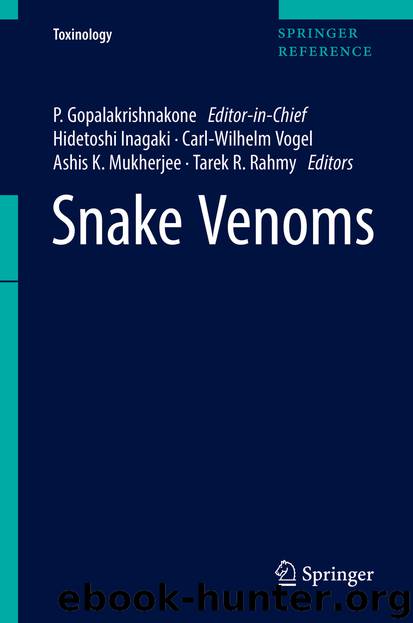Snake Venoms by Hidetoshi Inagaki Carl-Wilhelm Vogel Ashis K. Mukherjee & Tarek R. Rahmy

Author:Hidetoshi Inagaki, Carl-Wilhelm Vogel, Ashis K. Mukherjee & Tarek R. Rahmy
Language: eng
Format: epub
Publisher: Springer Netherlands, Dordrecht
Reconciling the Structural Data of the Different α-Neurotoxin: Receptor Complexes
There are differences in the conclusions arising from the major studies that examined complexes formed between 3Fα-NTxs and short cognate peptides of the nAChR binding site (Zeng et al. 2001; Moise et al. 2002a), with the α1-subunit of the nAChR (Dellisanti et al. 2007), with the AChBP (Bourne et al. 2005), and with a AChBP-α7 nAChR chimera (Huang et al. 2013). These differences can be attributed to a multitude of factors, including limitations in resolution (4.2 Å) of the α-cobratoxin-AChBP complex structure (Bourne et al. 2005), difficulty in extrapolating information gleaned from short peptide segments to the intact nAChR (Zeng et al. 2001; Moise et al. 2002b), and absence of the complementary subunit in the formation of the complex in the case of the α-bungarotoxin – α1 subunit of the nAChR (Dellisanti et al. 2007). Nonetheless, all these studies agreed on the critical points of toxin-receptor interactions, which have also largely been substantiated by early mutational analysis. Importantly, the role of critical aromatic amino acids (e.g., Tyr184, Tyr190) as well as residues that are their direct neighbors, at the interface of the nAChR ligand-binding site, has been verified in the binding of 3Fα-NTxs. In particular, the role of loop C from the α1 subunit as the primary element essential for binding 3Fα-NTxs has been established. A multi-point attachment of the 3Fα-NTx to the receptor has also been observed, with the 3Fα-NTx binding perpendicularly to the receptor axis. The primary interaction of the toxin occurred via the tip of loop II, with Arg33/Arg36 playing the most crucial role, while loop I and the carboxy-terminal tail also contributed to contacts with the receptor surface. Significant flexibility of the carboxy-terminal tail and loop I as well as flexibility and conformational changes of the tip of loop II were also noted, which is proposed to have functional ramifications, allowing for dynamic interactions with previously inaccessible parts of the toxin and receptor.
Download
This site does not store any files on its server. We only index and link to content provided by other sites. Please contact the content providers to delete copyright contents if any and email us, we'll remove relevant links or contents immediately.
Sapiens: A Brief History of Humankind by Yuval Noah Harari(14257)
The Tidewater Tales by John Barth(12609)
Mastermind: How to Think Like Sherlock Holmes by Maria Konnikova(7233)
Do No Harm Stories of Life, Death and Brain Surgery by Henry Marsh(6891)
The Thirst by Nesbo Jo(6832)
Why We Sleep: Unlocking the Power of Sleep and Dreams by Matthew Walker(6620)
Life 3.0: Being Human in the Age of Artificial Intelligence by Tegmark Max(5478)
Sapiens by Yuval Noah Harari(5295)
The Longevity Diet by Valter Longo(5021)
The Body: A Guide for Occupants by Bill Bryson(4978)
The Rules Do Not Apply by Ariel Levy(4868)
The Immortal Life of Henrietta Lacks by Rebecca Skloot(4528)
Animal Frequency by Melissa Alvarez(4399)
Why We Sleep by Matthew Walker(4364)
The Hacking of the American Mind by Robert H. Lustig(4319)
Yoga Anatomy by Kaminoff Leslie(4310)
All Creatures Great and Small by James Herriot(4235)
Double Down (Diary of a Wimpy Kid Book 11) by Jeff Kinney(4209)
Embedded Programming with Modern C++ Cookbook by Igor Viarheichyk(4110)
